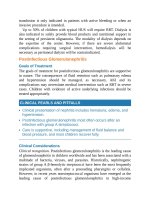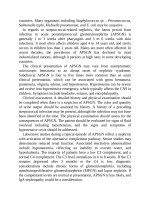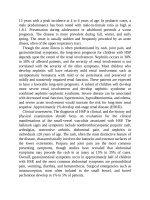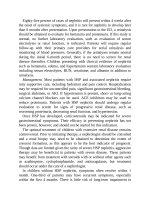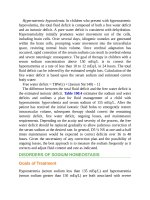Pediatric emergency medicine trisk 28
Bạn đang xem bản rút gọn của tài liệu. Xem và tải ngay bản đầy đủ của tài liệu tại đây (105.67 KB, 4 trang )
Leadership
Strategy
Actions and outcomes
Collegial Physician, RN
Leadership
Shared goals, mission
Leveled hierarchy
Team oriented
Shared values
Shared knowledge
Encourage new ideas
Transparency
Engage the frontline
members
Delegate work
Honor the team for great
work done
All members of the team
are invited, Include all
who have a role in
what the patient
experiences
Web-based agenda, team
members encouraged
to share their work
Meeting Platforms Multidisciplinary
Open agenda
Promote discussion
New projects are vetted
Feedback is
incorporated
Stakeholders are
included
Communication
Daily situational
awareness e-mail
MD/RN Leadership
rounds
Patient rounds every
shift
Multidisciplinary
Patient centered care
I-PASS handoff
Electronic track board
Prepares the team for the
day
Standardized
communication
Repeat back, clarify
Closed-loop
communication
List of patients, list of
actions, shows where
patient is in the
process, includes
ability to enter a
message
Team Structure,
Physical Space
Team Assessment
Defined geographic
cohort of 12–15 beds
Core members
Attendings
Nurses
Frontline clinicians
Social work
Child life
Respiratory therapy
Patient care associates
RN and MD/APP meet
the patient together at
the start of the visit
Temporary, smaller
teams work together in
the same location for a
designated shift
Brief introductions occur
at rounds
Family meets the team at
the outset
Decreased duplicative
interviews
Promotes team members
to be on the same page
Promotes shared
perspectives and
knowledge sharing
Sets expectations for the
team which includes
the patient and the
family
Clinical Standards Clinical pathways
Shared mental model
program
Sets team expectations
Guides care for common Platform for
chief complaints,
communication
diseases
Work done with
subspecialists
ED team can implement
care and reduce delays
as well as unnecessary
Patient
Communication
Boards
Organized
Discharge
Multidisciplinary
QI Projects
Simulation
Debriefs
variation and overtesting
Clinical decision support
to assist bedside work
Sets expectations of visit Updated throughout the
with patient and
stay
family
Provides timeline
List of actions
Promotes discussion and
mutual decision
making
MD, APP, RN Team
Complex discharge, done
take responsibility for
by MD, APP
discharge
Routine done by RN
Team collaboration to
Promotes
improve patient care
multidisciplinary
and remove potential
solutions
barriers that cause
Assists in flattened
frustration
hierarchy
All team members
responsible for “boots
on the ground”
education
Multidisciplinary
Team practices good
team behaviors
High-fidelity
mannequins
Closed-loop
communication
Shared mental models
Mutual respect
Recorded resuscitation Multidisciplinary team
reviews
reviews medical and
trauma resuscitations
Real-time patient events
Good team behaviors are
called out
Conflict
Identifies areas for
improvement
Debrief, assign roles
before event when
possible
Teams gather following
resuscitations, sexual
assault evaluations,
physical restraint
episodes, etc. briefly
to identify what went
well, share
ideas/perspectives for
further improvement
Focus on what is best for Emphasize importance of
the patient and the
listening
family
Avoid blame
Strategies to Enhance Teamwork
Team work is critical to achieve the best patient outcomes and experience
and staff engagement. It is also a requirement for continued improvement
and innovation of the care model, the care delivery, and the environment.
Team members recognize that they have shared responsibility for clinical
decision making, the process through which care is delivered as well as
physical, experiential, and cost outcomes.
Table 4.2 provides some strategies to build a culture that supports strong
interdisciplinary team work.
CONCLUSION
Improved patient outcomes come from taking a team approach to the
clinical care of patients. Collaboration streamlines care and reduces error.
This is increasingly more important as complexity of care and technology
continues to grow. Healthcare leadership must incorporate education and
resources to promote teamwork to assure clinical excellence and continued
innovation.



